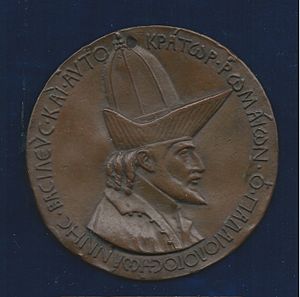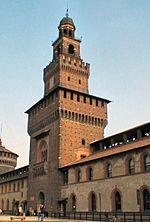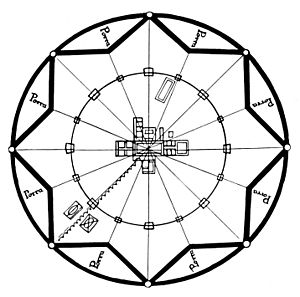Filarete facts for kids
Antonio di Pietro Averlino (around 1400 – around 1469), known as Filarete, was a famous Florentine Renaissance architect, sculptor, and designer. His nickname "Filarete" means "lover of excellence." He is best known for creating the plan for an ideal city called Sforzinda. This was the first ideal city plan of the Renaissance period.
Contents
Biography
Antonio di Pietro Averlino was born in Florence around 1400. He likely trained there as a craftsman. Some sources say he worked with Lorenzo Ghiberti, a well-known Italian artist. Ghiberti is said to have given him the name "Filarete." This name means "a lover of virtue."
In the mid-1400s, Filarete moved from Rome to Venice. Then he went to Milan. In Milan, he became a special engineer for the duke. He worked on many building projects for about fifteen years. Filarete died in Rome around 1469.
Works

Bronze Doors of Old St. Peter's Basilica
Pope Eugene IV asked Filarete to create the large bronze doors for Old St. Peter's Basilica in Rome. Filarete worked on these doors for twelve years. They were finished in 1445. Even though they were made during the Renaissance, the doors show older styles. They have influences from the Byzantine period and the Middle Ages. Some experts say the doors show Filarete's mix of old and new ideas.
Architectural Works
In Milan, Filarete designed the Ospedale Maggiore around 1456. This was a large hospital. Its overall shape was planned like a cross inside a square. The hospital church was in the very center. Some parts of the hospital that still exist show older Gothic details. These details were common in Milan during the 1400s. They were different from Filarete's more classical "after the Antique" style. Filarete also worked on the Castello Sforzesco, also known as Sforza Castle. He also helped with the Duomo di Milano, which is the Milan Cathedral.
Filarete's Book on Architecture and the Ideal City of Sforzinda
Filarete finished his important book about architecture around 1464. He called it his Libro architettonico, meaning "Architectural Book." Today, people usually call it a Trattato or "Treatise." This book had twenty-five parts. Many copies of it were passed around during the Renaissance.
The book is written like a story. It talks a lot about the technical parts of building. This includes choosing a good location and materials. It also covers drawing and construction methods. Filarete also strongly argued against the Gothic style of Northern Italy. He called it the "barbarous modern style." Instead, he promoted using classical Roman building styles.
The most famous part of his book is his plan for Sforzinda. This was an ideal city named after Francesco Sforza, who was the Duke of Milan. Sforzinda was never actually built. However, many details of its design are described in the book.
The city's basic shape was an eight-point star. This was made by putting two squares on top of each other. All the corners were equally far apart. This star shape was then surrounded by a perfect circular moat. This special shape might show Filarete's interest in magic and astrology. He also gave advice on how to make the city feel harmonious.
For the city's layout, each outer point of the star had towers. The inner corners had gates. Each gate led to main roads that spread out from the center. These roads passed through market squares, each for different goods. All the main roads met in a large central square. The city had three main squares: one for the prince's palace, one for the cathedral, and one for the market.
Because people in the Renaissance liked the idea of canal towns, Sforzinda had canals on every other street. These canals were for moving goods. The canal system also connected to a river. This allowed goods to be brought in and sent out. The city also had many other buildings. These included churches and separate schools for boys and girls.
The design of Sforzinda might have been a response to older Italian cities. These cities often grew without much planning. This made them hard to get around. Renaissance thinkers were interested in old texts. This led them to think about using geometry in city designs. For example, Plato described a city with a geometric layout in his story of Atlantis. Filarete's ideal city plan was meant to show a perfect society. The idea was that a perfect city shape would create a perfect society. This was a common idea during the Renaissance. The ideal city also suggested that a powerful ruler was needed to organize it. This idea was similar to Dante's thought that "The human race is at its best under a monarch."
Influence on Architecture and Urbanism
Filarete's plan for Sforzinda was the first ideal city plan of the Renaissance. His detailed organization of the city showed a new level of city planning. Even though Sforzinda's design included some older symbols, its main ideas became a model for cities during the High Renaissance. Many important leaders, like Giangaleazzo Sforza and Piero di Cosimo de' Medici, were interested in his book. Later, when Francesco di Giorgio and Leonardo da Vinci planned their own ideal cities, they used some of Filarete's ideas.
Even though Sforzinda was never built, it inspired many future city plans. For example, in the 1500s, military engineers and architects combined Filarete's ideal city ideas with defensive walls. This idea of mixing an ideal city with strong defenses became very popular across Europe and beyond.
See also
 In Spanish: Filarete para niños
In Spanish: Filarete para niños



